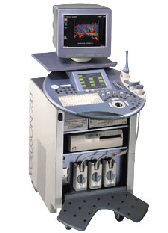Medical Ultrasound Imaging
Monday, 13 May 2024
'Inversion' p3 Searchterm 'Inversion' found in 15 articles 2 terms [ • ] - 13 definitions [• ] Result Pages : •
The degree that a transducer is finely tuned to specific narrow frequency range. For example: A low Q-value means wide bandwidth and high Q-value means narrow bandwidth. See also Pulse Inversion Doppler, Narrow Bandwidth, Dead Zone, Ultrasound Phantom. •
Real-time mode has been developed to present motion like a movie of the body's inner workings, showing this information at a high rate. The special real-time transducer uses a larger sound beam than for A, B or M-modes. A linear array transducer with multiple crystal elements displays real-time compound B-mode images with up to 100 images per second. At each scan line, one sound pulse is transmitted and all echoes from the surface to the deepest range are received. Then the ultrasound beam moves on to the next scan line position where pulse transmission and echo recording are repeated. See also Compound B-Mode, Pulse Inversion Doppler, and Frame Averaging. Further Reading: News & More:
•
Reflux sonography, as an alternative to micturating cystography (MCU), evaluates vesico-ureteral reflux (VUR), a common problem in children. Contrast enhanced pulse-inversion imaging shows best results. During the instillation of an ultrasound contrast agent into the bladder, (as for a conventional MCU) the lower ureters and renal pelves are scanned transabdominally as the bladder is filled to stimulate micturition. Advantages for reflux sonography are a high sensitivity and the avoidance of X-rays. A disadvantage is the poorer depiction of the posterior urethra. However, for girls and for all follow-up studies, the ultrasound MCU has become standard in many pediatric ultrasound departments. See also Urologic Ultrasound, Kidney Ultrasound, Ultrasound Safety, Ultrasound Imaging Modes. •
Tissue-specific ultrasound contrast agents improve the image contrast resolution through differential uptake. The concentration of microbubble contrast agents within the vasculature, reticulo-endothelial, or lymphatic systems produces an effective passive targeting of these areas. Other contrast media concepts include targeted drug delivery via contrast microbubbles. Tissue-specific ultrasound contrast agents are injected intravenously and taken up by specific tissues or they adhere to specific targets such as venous thrombosis. These effects may require minutes to several hours to reach maximum effectiveness. By enhancing the acoustic differences between normal and diseased tissues, these tissue-specific agents improve the detectability of abnormalities. Some microbubbles accumulate in normal hepatic tissue; some are phagocytosed by Kupffer cells in the reticuloendothelial system and others may stay in the sinusoids. Liver tumors without normal Kupffer cells can be identified by the lack of the typical mosaic color pattern of the induced acoustic emission. The hepatic parenchymal phase, which may last from less than an hour to several days, depending on the specific contrast medium used, may be imaged by bubble-specific modes such as stimulated acoustic emission (color Doppler using high MI) or pulse inversion imaging. Further Reading: News & More:
•  From GE Healthcare.;
From GE Healthcare.;'GE is defining a new age of ultrasound. We call it Volume Ultrasound. GE's Voluson 730 Expert is a powerful system that enables real-time techniques for acquiring, navigating and analyzing volumetric images so that you can make clinical decisions with unprecedented confidence.'
Device Information and Specification
APPLICATIONS
Abdominal, breast, cardiac, musculoskeletal, neonatal, OB/GYN, pediatric, small parts, transcranial, urological, vascular
CONFIGURATION
15' high resolution non-interlaced flat CRT, 4 active probe ports
B-mode, M-mode, coded harmonic imaging (2-D), color flow mode (CFM), power Doppler imaging (PDI), color Doppler, pulsed wave Doppler, high pulse repetition frequency (HPRF) Doppler, tissue harmonic imaging, 3-D power Doppler
IMAGING OPTIONS
CrossXBeam spatial compounding, coded excitation , spatio-temporal image correlation (STIC), B-Flow (simultaneous imaging of tissue and blood flow), strain rate imaging (SRI)
OPTIONAL PACKAGE
STORAGE, CONNECTIVITY, OS
SonoView archiving and data management, network, HDD, DICOM 3.0, CD/DVD, MOD, USB, Windows-based
DATA PROCESSING
Digital beamformer with 512 system processing channel technology
H*W*D m (inch.)
1.43 * 0.69 * 1.02 (56 * 27 * 40)
WEIGHT
136 kg (300 lbs.)
Result Pages : |
Medical-Ultrasound-Imaging.com
former US-TIP.com
Member of SoftWays' Medical Imaging Group - MR-TIP • Radiology TIP • Medical-Ultrasound-Imaging
Copyright © 2008 - 2024 SoftWays. All rights reserved.
Terms of Use | Privacy Policy | Advertise With Us
former US-TIP.com
Member of SoftWays' Medical Imaging Group - MR-TIP • Radiology TIP • Medical-Ultrasound-Imaging
Copyright © 2008 - 2024 SoftWays. All rights reserved.
Terms of Use | Privacy Policy | Advertise With Us
[last update: 2023-11-06 01:42:00]




